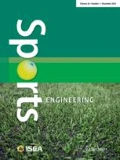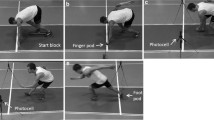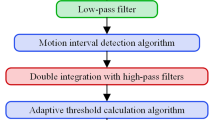Abstract
The assessment of sprint velocity is useful for evaluating performance and guiding training interventions. In this paper, we describe an adaptive filtering algorithm to estimate sprint velocity using a single, sacrum-worn magneto-inertial measurement unit. Estimated instantaneous velocity, average 10 m interval velocity, and peak velocity during 40 m sprints from the proposed method were compared to a reference method using photocell position-time data. Concurrent validity of the proposed method was assessed using mean absolute error and mean absolute percent error for all velocity estimates. The significance of the mean error was assessed using a factorial ANOVA for average interval velocity and a paired-samples t test for peak velocity. Reliability was assessed using Bland–Altman 95% limits of agreement for repeated measures. Average interval velocity was underestimated early in the sprint (− 0.25 to − 0.05 m/s) and overestimated later (0.13 m/s) with mean absolute error between 0.20 m/s (3.95%) and 0.62 m/s (7.78%). The average mean absolute error was 0.45 m/s (7.02%) for instantaneous velocity and 0.63 m/s (7.84%) for peak velocity. The limits of agreement grew progressively wider at greater distances (− 0.59 to 0.34 m/s for 0–10 m and − 1.32 to 1.59 m/s for 30–40 m). The estimation error from the proposed method is comparable to other wearable sensor-based methods and suggests its potential use to assess sprint performance.










Similar content being viewed by others
References
Rabita G et al (2015) Sprint mechanics in world-class athletes: a new insight into the limits of human locomotion: sprint mechanics in elite athletes. Scand J Med Sci Sports 25(5):583–594
Furusawa K, Hill AV, Parkinson JL (1927) The dynamics of ‘sprint’ running. Proc R Soc Lond Ser B Contain Pap Biol Character 102(713):29–42
Samozino P et al (2016) A simple method for measuring power, force, velocity properties, and mechanical effectiveness in sprint running: simple method to compute sprint mechanics. Scand J Med Sci Sports 26(6):648–658
Bezodis NE, Salo AIT, Trewartha G (2012) Measurement error in estimates of sprint velocity from a laser displacement measurement device. Int J Sports Med 33(6):439–444
Morin JB, Samozino P, Bonnefoy R, Edouard P, Belli A (2010) Direct measurement of power during one single sprint on treadmill. J Biomech 43(10):1970–1975
Waldron M, Worsfold P, Twist C, Lamb K (2011) Concurrent validity and test–retest reliability of a global positioning system (GPS) and timing gates to assess sprint performance variables. J Sports Sci 29(15):1613–1619
Petersen C, Pyne D, Portus M, Dawson B (2009) Validity and reliability of GPS units to monitor cricket-specific movement patterns. Int J Sports Physiol Perform 4(3):381–393
Varley MC, Fairweather IH, Aughey RJ (Jan. 2012) Validity and reliability of GPS for measuring instantaneous velocity during acceleration, deceleration, and constant motion. J Sports Sci 30(2):121–127
Jennings D, Cormack S, Coutts AJ, Boyd L, Aughey RJ (2010) The validity and reliability of GPS units for measuring distance in team sport specific running patterns. Int J Sports Physiol Perform 5(3):328–341
Romero-Franco N et al (2016) Sprint performance and mechanical outputs computed with an iPhone app: comparison with existing reference methods. Eur J Sport Sci 17:1–7
Setuain I, Lecumberri P, Ahtiainen JP, Mero AA, Häkkinen K, Izquierdo M (2018) Sprint mechanics evaluation using inertial sensor-based technology: a laboratory validation study. Scand J Med Sci Sports 28(2):463–472
Parrington L, Phillips E, Wong A, Finch M, Wain E, MacMahon C (2016) Validation of inertial measurement units for tracking 100 m sprint data. In: 34th Int. conf. biomech. sport
Seco-Granados G, Lopez-Salcedo J, Jimenez-Banos D, Lopez-Risueno G (2012) Challenges in indoor global navigation satellite systems: unveiling its core features in signal processing. IEEE Signal Process Mag 29(2):108–131
Sabatini AM (2011) Estimating three-dimensional orientation of human body parts by inertial/magnetic sensing. Sensors 11(12):1489–1525
Lidstone DE, Stewart JA, Gurchiek R, Needle AR, van Werkhoven H, McBride JM (2017) Physiological and biomechanical responses to prolonged heavy load carriage during level treadmill walking in females. J Appl Biomech 33(4):248–255
McGinnis RS, Cain SM, Davidson SP, Vitali RV, Perkins NC, McLean SG (2016) Quantifying the effects of load carriage and fatigue under load on sacral kinematics during countermovement vertical jump with IMU-based method. Sports Eng 19(1):21–34
McGinnis RS, Cain SM, Davidson SP, Vitali RV, McLean SG, Perkins NC (2015) Inertial sensor and cluster analysis for discriminating agility run technique. IFAC Pap 48(20):423–428
McGinnis RS et al (2017) A machine learning approach for gait speed estimation using skin-mounted wearable sensors: from healthy controls to individuals with multiple sclerosis. PLoS One 12(6):e0178366
Yang S, Mohr C, Li Q (2011) Ambulatory running speed estimation using an inertial sensor. Gait Posture 34(4):462–466
Bergamini E, Picerno P, Pillet H, Natta F, Thoreux P, Camomilla V (2012) Estimation of temporal parameters during sprint running using a trunk-mounted inertial measurement unit. J Biomech 45(6):1123–1126
Wixted AJ, Billing DC, James DA (2010) Validation of trunk mounted inertial sensors for analysing running biomechanics under field conditions, using synchronously collected foot contact data. Sports Eng 12(4):207–212
Bergamini E, Guillon P, Camomilla V, Pillet H, Skalli W, Cappozzo A (2013) Trunk inclination estimate during the sprint start using an inertial measurement unit: a validation study. J Appl Biomech 29(5):622–627
Gurchiek RD, McGinnis RS, Needle AR, McBride JM, van Werkhoven H (2017) The use of a single inertial sensor to estimate 3-dimensional ground reaction force during accelerative running tasks. J Biomech 61:263–268
de Vries WHK, Veeger HEJ, Baten CTM, van der Helm FCT (2009) Magnetic distortion in motion labs, implications for validating inertial magnetic sensors. Gait Posture 29(4):535–541
Simon D (2006) Optimal state estimation. Wiley, Hoboken
Favre J, Jolles BM, Siegrist O, Aminian K (2006) Quaternion-based fusion of gyroscopes and accelerometers to improve 3D angle measurement. Electron Lett 42(11):612–614
Kuipers JB (1999) Quaternions and rotation sequences. Princeton University Press, Princeton
Hodges PW, Bui BH (1996) A comparison of computer-based methods for the determination of onset of muscle contraction using electromyography. Electroencephalogr Clin Neurophysiol 101(6):511–519
Martinez-Mendez R, Sekine M, Tamura T (2011) Detection of anticipatory postural adjustments prior to gait initiation using inertial wearable sensors. J Neuroeng Rehabil 8:17
Nichols JA, Bednar MS, Havey RM, Murray WM (2016) Decoupling the wrist: a cadaveric experiment examining wrist kinematics following midcarpal fusion and scaphoid excision. J Appl Biomech 33:1–29
Atkinson G, Nevill AM (1998) Statistical methods for assessing measurement error (reliability) in variables relevant to sports medicine. Sports Med 26(4):217–238
Giavarina D (2015) Understanding Bland–Altman analysis. Biochem Med 25(2):141–151
Acknowledgements
This project was partially funded by the Appalachian State University Office of Student Research.
Author information
Authors and Affiliations
Corresponding author
Electronic supplementary material
Below is the link to the electronic supplementary material.
Rights and permissions
About this article
Cite this article
Gurchiek, R.D., McGinnis, R.S., Needle, A.R. et al. An adaptive filtering algorithm to estimate sprint velocity using a single inertial sensor. Sports Eng 21, 389–399 (2018). https://doi.org/10.1007/s12283-018-0285-y
Published:
Issue Date:
DOI: https://doi.org/10.1007/s12283-018-0285-y




